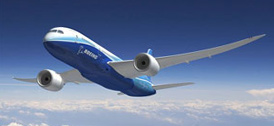The 787-8 Dreamliner can fly 242 passengers up to 7,350 nautical miles (13,620 km) in a typical two-class configuration. The 787-9, a stretch of the 787-8, can fly 290 passengers 7,635 nautical miles (14,140 km) in addition to more cargo, allowing airlines the ability to grow routes first opened by the 787-8. The third and longest 787, the 787-10, will fly 330 passengers up to 6,430 nautical miles (11,910 km), or more than 90 percent of the world’s twin-aisle routes, when deliveries begin in 2018.
The 787 family is delivering unmatched fuel efficiency to our customers, keeping them competitive in this challenging economic environment. With 20 to 25 percent less fuel and 20 to 25 percent fewer emissions than the airplanes they replace, the 787 family has saved a projected 2.8 billion pounds of fuel since entering service in 2011. The 787 also travels at a similar speed as today’s fastest twin-aisle airplanes, Mach 0.85. Airlines also realize more cargo revenue capacity — a 20 to 45 percent advantage over replacement airplanes.
Passengers enjoy many improvements with the 787 family such as the industry’s largest windows; air that is cleaner, more humid and at a higher pressure for greater comfort; large overhead bins with room for everyone’s bag; soothing LED lighting; and technology that senses and counters turbulence for a smoother ride.

